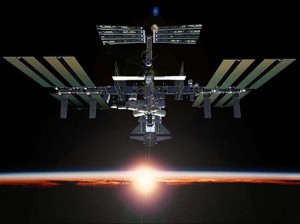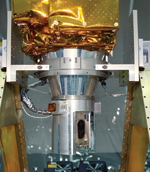
By Ed Mauldin
What Is Prototyping?
Prototyping is probably the oldest method of design. It is typically defined as the use of a physical model of a design, as differentiated from an analytical or graphic model. It is used to test physically the essential aspects of a design before closing the design process (e.g., completion and release of drawings, beginning reliability testing, etc.). Prototypes may vary from static “mockups” of tape, cardboard, and styrofoam, which optimize physical interfaces with operators or other systems, to actual functioning machines or electronic devices. They may be full or sub-scale, depending on the particular element being evaluated. In all cases, prototypes are characterized by low investment in tooling and ease of change.
Something New on the Horizon
The Sage III instrument was a spectrometer designed to point at the sun during sunrise/sunset and at the moon during moonrise/moonset in order to unravel the vertical distribution of ozone and aerosols in the stratosphere.
At the time when we were working on this project, which was in 1992, the Clinton-Gore administration had just taken office, and the Soviet Union had just broken up. Russian Prime Minister Victor Chernomyrdin and Vice President Al Gore formed a commission to draw the two former enemies closer together. They were looking for potential joint ventures between the two countries. The SAGE III was in a marketing campaign looking for a ride on a NASA spacecraft when we were told that we had been selected to be one of the eight initial ventures in the Gore-Chernomyrdin Commission (GCC).
This raised the visibility of our project at the Langley Research Center to the highest level. We would report directly to the Vice President twice a year, and our Center director wanted zero chance of failure on this program. And while these were certainly benefits to our project, our new focus and Russian partners were going to change it considerably. Once the project became part of the GCC, we had to make major adjustments. We were going to have to adapt our instrument to the infrastructure of a Russian Meteor spacecraft and Russian Flight Control Center. We decided to use rapid prototyping to integrate the changes.
Facing Up to Interfaces
In many cases, aspects of Russian spacecraft control panels were opposite of those in American spacecraft. For example, the Russian electronics were positive-grounded and ours negative-grounded. Interfaces that get very little attention between American instruments and American spacecraft became major issues in the Russian spacecraft. There’s nothing as frustrating as knowing your triple-redundant system needs to attach three wires to their dual-redundant two.
We spent an entire year designing and testing special bolts for attaching our instrument to the spacecraft. We built and tested prototypes for each difference in our systems. In each case, problems were discovered during prototype testing, and the solutions that were applied to the flight hardware as we struggled to make the prototype work resulted in our saving a considerable amount of money and time.
Along with the Russians, we built interface simulators that were exact copies of the flight interface designs, and these simulators went through a rigorous test program. Many of the original designs didn’t work, and they had to be redesigned, rebuilt, and retested.
Designing a New Generation
SAGE III was a fourth generation instrument, and many of the subsystems were radical departures from those of previous generations. The “new” designs turned into a huge problem for us. We were very concerned about certain systems, so we purchased parts early in the life of the project to make sure they would meet our needs. Some didn’t. In one particular instance we had a part delivered five times incorrectly, and we didn’t have the time or budget to go for a sixth delivery. We relied on prototyping to test a series of hardware and software repairs for the system.
The older designs were huge problems in some cases as well. Parts no longer existed. Processes no longer existed. People who knew how to assemble the instrument or manufacture the instrument had retired. One of our biggest challenges had to do with an older design for a flex-cable on the flight instrument. The problem had been solved four separate times — each time a new generation of the instrument was built. Even though we had the flight drawings, all of the manufacturing procedures, and everything in front of us, we could not reproduce that flex-cable. We had to essentially start from scratch each time because the processes were different and the people were different.
We used rapid prototyping to solve the issues with the flex-cable. This taught us a valuable lesson: very early in the system design process, you should identify the older subsystem designs that will be hard to reproduce and submit these to rapid prototyping.
Tapping Resources
You can use prototyping simply for troubleshooting, but I think there is an even better reason to employ this practice. By prototyping, you’re actually getting to use some of the most talented people on your team, which are your machinists and your technicians. A machinist can be a wonderful help in a design. When you sit down with your machinist with a sketch of a prototype and say, “This is what I want to do,” he can say, “Well, we really should use this material instead of that material.”
The same goes with your technicians. They can say, “You know, you really should have a port here for an alignment… You know, you need a hole here… You need a removable bracket here.” You don’t get that if you go straight to flight hardware. You’re not using these people’s minds; you’re only using their hands. When you take a flight drawing to a machinist, he gets no say. If you have a piece of aluminum with a hole in it bigger than the aluminum itself, he will deliver you an envelope full of metal shavings. That has happened to me in the past.
Model Citizens
On this project, and really on all my projects, prototyping was standard procedure. SAGE III launched successfully on December 10, 2001. Less than a month later, NASA lost communication with the spacecraft when the main transmitter went out and the Russian GPS receiver didn’t work.
This is when all our joint repairs with the Russians really paid off. Because of our intensive work together during the prototyping phase, we had developed into a high-performance, unified, international team. This close situation led each side to have an excellent understanding of the other side’s half of the interface. And in turn, this understanding led to quick, joint solutions to extremely difficult problems. In the end, together we were able to overcome the transmitter failure. This got SAGE III operating and sending its invaluable stratospheric data back to Earth. And this data is the key to understanding ozone destruction in the stratosphere.
Search by lesson to find more on:
- Communication










